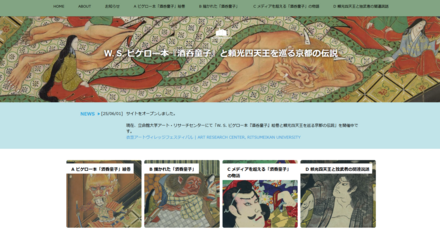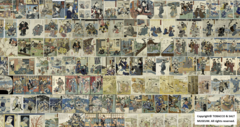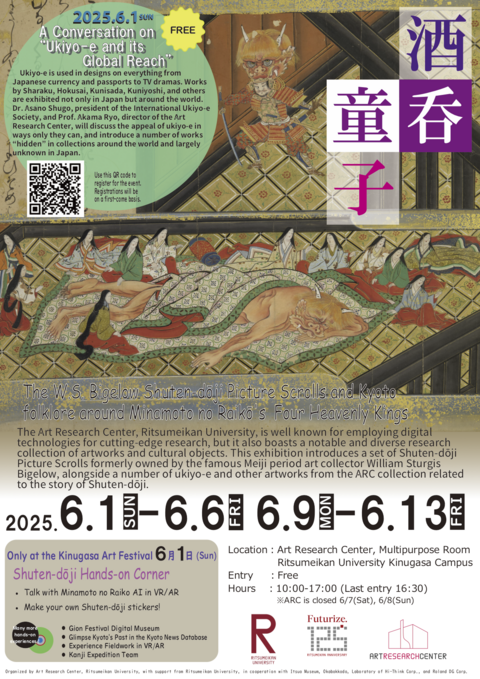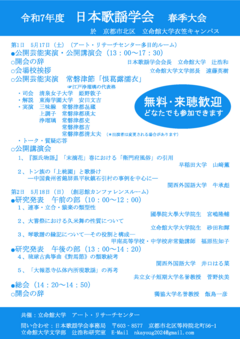-
[イベント情報]August 1, 2025(Fri)
The Art Research Center (ARC) at Ritsumeikan University is pleased to announce that more than 2,600 ukiyo-e prints in the collection of the Tobacco & Salt Museum in Tokyo have now been made publicly available in the ARC Database System.
These works can be found by searching for "tsm" in the "Owner" field in the ARC Japanese Prints (Ukiyo-e) and Paintings Portal Database.
https://www.dh-jac.net/db/nishikie/search_tsm.php
The Tobacco & Salt Museum's collection of ukiyo-e chiefly consists of materials collected by the Monopoly Bureau of the Ministry of Finance, Japan, beginning in 1932, for the purposes of understanding the history and development of smoking culture. It is valuable not only for learning about the cultural history of tobacco, but also as a fascinating resource for industrial and commercial history. The collection includes materials spanning from the early Edo period to the Meiji period, and features works by a diversity of artists.The Museum published a catalog in 2010 entitled "Ukiyo-e hanga," complete with color plates. Now, nearly the entire collection is made available to view online.
Please enjoy and make use of this newly-available resource.
[イベント情報]July 30, 2025(Wed)Art Research Center (ARC) Director, Professor Akama will give a special lecture.Cultural Resources x Generative AI x Latest VR] Latest Trends in Digital Archives and VR Experience, to be held at Kyoto Research Park!(Organized by Hi-Think Soken Co., Ltd. and co-organized by Kyoto Research Park Corporation).This is a special event to introduce the frontline of digital archives in museums and art galleries and the latest trends in VR content creation using rapidly evolving generative AI.Date: Thursday, July 31, 2025, 18:00-20:00Location: Kyoto Research Park, West Zone, Building 10, 1F "GOCONC" and onlineAdmission: Free of chargeApplication at: https://krpfes-lhc.peatix.com/For more information:The 33rd Special Exhibition "川を描く、川をつくる―古地図で昔の堤をさぐる―" is held at the Lake Biwa Museum, supported by the FY 2024 ARC-iJAC project "Development of a database on traditional river management information in the Echi River, Shiga Prefecture, Japan."
Date: July 19 (Sat) - November 24 (Mon), 2025
Hours: 9:30 AM - 5:00 PM (last admission at 4:00 PM)
Venue: Special Exhibition Room, Lake Biwa Museum, Shiga Prefecture[イベント情報]July 9, 2025(Wed)京都市指定有形文化財 長江家住宅で開催される屏風祭を下記の通りお知らせします。
【屏風祭とは】
祇園祭では、宵山の期間に山鉾町周辺の旧家や老舗がミセの間を屏風や嗜好品などで飾りたてる習慣があり、屏風祭と呼ばれています。
2025年に行われる長江家住宅の屏風祭では、「昭和100年」を今回のテーマとして、屏風や掛け軸、デジタルコンテンツ、日用品などの展示を行います。【開催概要】
2025年7月13日(日) 午後 1時から午後6時迄(午後5時30分受付終了)
2025年7月14日(月)~16日(水) 午前10時から午後8時迄(午後7時30分受付終了)
※16日 午後1時から午後2時の間は貸切予約のためご見学いただけません。予約は不要ですが、団体見学の方は事前にご予約ください。
ご見学料 お一人様1,000円(ノベルティ付)
(キャッシュレス対応有)主催:(株)フージャースホールディングス
共催:立命館大学アート・リサーチセンター【お問合せ】
メール nagaeke@hoosiers.co.jp
電話 075-353-7512(不在の場合もございます)長江家住宅 http://www.nagaeke.jp/
長江家住宅2025年屏風祭 http://www.nagaeke.jp/misc_news/index.html?id=U23433461064071[イベント情報]July 9, 2025(Wed)We are holding a workshop that will visit Japan's historic washi production centers and delve into woodblock-printing techniques.
By learning directly at each site, the program aims to nurture the "next generation of woodblock artists," inspiring participants to channel these experiences into fresh creative expression.※Please see the PDF for full application requirements.
【Who We Are Looking For】
・Artists who create works using woodblock-printing techniques
・Artists who employ traditional Japanese woodblock skills (carving and printing) in their work
・No restrictions on nationality or age
【Number of Participants】
10 artists
【Workshop Outline】
・Travel to Kōchi, Mino, and Echizen to study the specific features of their respective washi papermaking traditions and explore new expressive possibilities arising from different raw materials.
・Share new insights that will support future creative practice.
【Schedule】
12-19 Oct 2025: Fieldwork workshop visiting production sites (Kyoto; Ino (Kōchi); Mino
(Gifu); Echizen (Fukui) [planned])
Mid-Dec 2025: Workshop results presentation (Hybrid)
Feb 2026: International symposium (Hybrid)【Financial Support】
Domestic travel within Japan only (for workshops, reporting sessions, and the symposium).
※Please note that travel costs from overseas to Japan are not eligible for funding.【How to Apply】Recruitment Closed
Fill in the required information on the application form .Send your CV to Akama Laboratory(E‑mail:cyanagihara.8918@gmail.com).・ The application form: deadline has passed
・Deadline: 31 July 2025, 23:59 (JST)deadline has passed※ Notification of results: by 10 August 2025
【Enquiries】
Akama Laboratory,Art Research Center, Ritsumeikan University
E-mail:cyanagihara.8918@gmail.com
[イベント情報]June 11, 2025(Wed)The 149th International ARC Seminar will be held as a webinar on Wednesday,June 11, from 18:30 JST.
The program is as follows:
Speakers: Osamu YOSHIDA (President, Tsukiji Sugoroku Museum)
Topic: 'Playing the Sugoroku of the Forest of Knowledge: Fun, Database, and History'
Date: Wednesday, June 11 , 2025, 18:30 - 20:00 JST
Participation: free of charge
Zoom webinar https://ritsumei-ac-jp.zoom.us/j/92428160002
Live streaming on YouTube https://www.youtube.com/@studioarc504
The seminar has been changed to a seminar open to all.
Please invite anyone who is interested.
[イベント情報]June 9, 2025(Mon)The Art Research Center (ARC) at Ritsumeikan University and its Director, Professor Ryo Akama, have been selected as recipients of the 19th (FY 2025) Nogami Hiroko Memorial Award by the Japan Art Documentation Society (JADS).
This honor recognizes the long-standing contributions of Professor Akama and the Center in leading the digitization and dissemination of cultural resources related to Japanese art and traditional performing arts.
The award ceremony will take place on Saturday, June 14, 2025, as part of the Annual Conference of the JADS.
Award details: https://www.jads.org/award/NOGAMI2025.pdf
Website of the Japan Art Documentation Society (JADS): https://www.jads.org/index.html
[イベント情報]June 1, 2025(Sun) The public exhibition "The William Sturgis Bigelow Shuten-dōji Picture Scrolls and Kyoto Folklore around Minamoto no Raikō's Four Heavenly Kings" is being held at the ARC Multipurpose Room from June 1 to June 13, 2025.
The public exhibition "The William Sturgis Bigelow Shuten-dōji Picture Scrolls and Kyoto Folklore around Minamoto no Raikō's Four Heavenly Kings" is being held at the ARC Multipurpose Room from June 1 to June 13, 2025.In conjunction with the physical exhibition, a virtual museum has also been launched, featuring additional works that are not on display at the venue.
Virtual Museum: https://www.arc.ritsumei.ac.jp/lib/vm/shutendoji25/
Details on the exhibition: https://www.arc.ritsumei.ac.jp/e/news/pc/025048.html
Notes:
The Association of Japanese Ballads and Songs (Nihon kayo gakkai) will hold its Spring 2025 meeting at the Ritsumeikan University Kinugasa campus.The two-day event includes performing arts demonstrations, lectures, and research talks open to the public. Free to attend; no registration necessary.
Date: Saturday, May 17 and Sunday, May 18, 2025
Place: Ritsumeikan University Kinugasa Campus (56-1 Toji-in Kitamachi, Kita-ku, Kyoto)
※Please note that the building (classroom) is different for the first and second days.Day 1 : May 17 (Sat)
Public Performing Arts Demonstration and Lectures (13:00-17:30)
Location: Art Research Center, Multipurpose StudioDay 2:May 18 (Sun), Research Presentations
Location: Conference Room, SoshikanFor more information, please see the Nihon Kayo Gakkai homepage: 令和7年度春季大会(zoom併用開催)
Please direct inquiries to the Nihon Kayo Gakkai at: Email: nkayoug2024@gmail.com

















